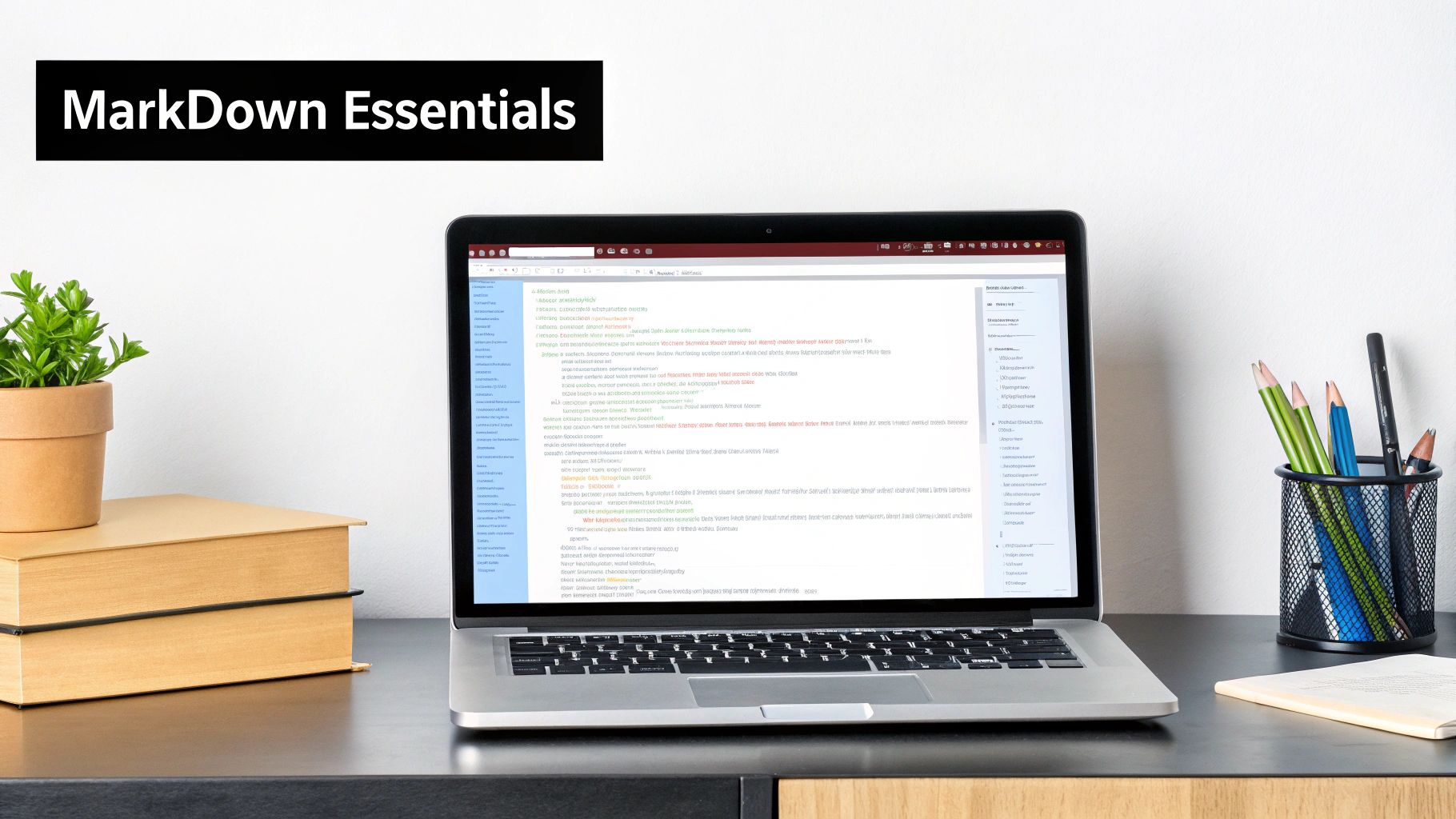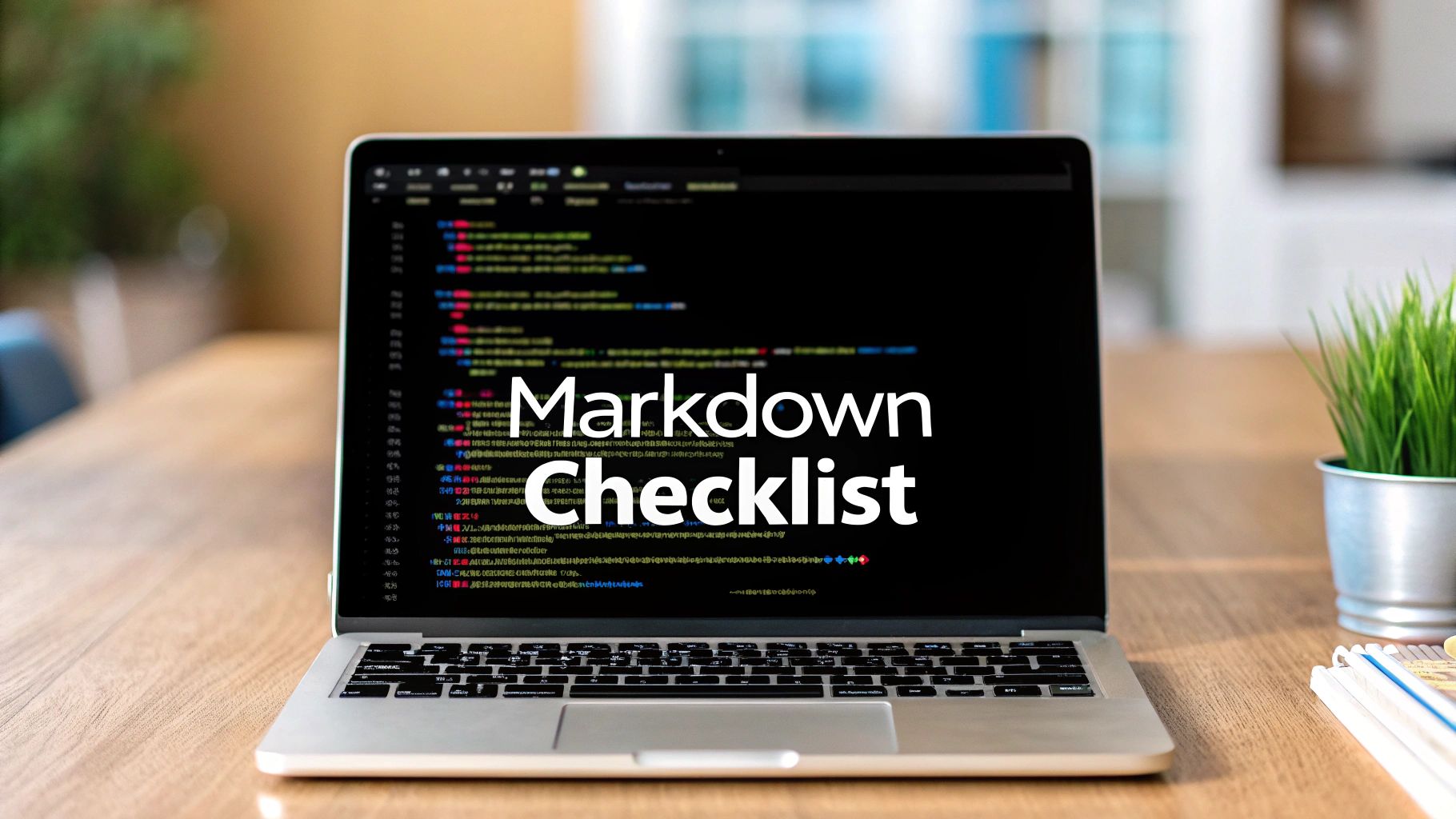Boost Productivity with Markdown Checklist GitHub Tips
The Evolution of GitHub Markdown Checklists

GitHub has become the vital hub for millions of software projects, enabling collaboration and efficient code management. A key factor in this success is its support for Markdown, a lightweight markup language simplifying documentation and communication. Markdown checklists have become an essential tool within this ecosystem, streamlining workflows and improving project management due to their simplicity and ease of use.
These checklists are crucial for coordinating tasks, tracking progress, and preventing oversight. They allow teams to divide complex projects into smaller, more manageable steps within the GitHub interface. Managing tasks in the same environment where code is developed and reviewed fosters tighter integration and reduces context switching.
Enhancing Collaboration With Real-Time Updates
GitHub markdown checklists are more than just simple to-do lists. They are dynamic project management tools, allowing teams to break down complex tasks. These checklists are interactive, allowing team members to update progress in real-time by clicking checkboxes.
The syntax is straightforward: - [ ] for incomplete tasks and - [x] for completed ones. This feature, part of GitHub Flavored Markdown since 2013, has significantly improved collaboration and reduced manual updates. For example, when a checklist-referenced issue is closed, the corresponding item is automatically marked complete, keeping everyone informed effortlessly. Learn more about GitHub Markdown checklists: The Ultimate Guide to GitHub Markdown Checklists
This real-time updating significantly improves team communication and transparency. Imagine multiple developers working on different parts of a single feature. With markdown checklists, each developer can mark their individual tasks as complete, providing instant visibility into the overall progress. This reduces the need for constant status meetings and emails, freeing up valuable time.
Leveraging Checklists for Consistent Workflows
Checklists also promote consistency across projects and teams. By creating standardized checklist templates, organizations can ensure crucial steps aren't missed, regardless of who is working on a task. This consistency is vital in larger teams or organizations where maintaining uniform processes can be challenging. Ultimately, using checklists helps maintain high quality and reduces the risk of errors.
Beyond Basic Task Management: Checklists for Complex Projects
The need for more efficient and integrated project management within GitHub has driven the evolution of markdown checklists. As projects grow more complex and involve numerous contributors, these simple tools have evolved to offer greater flexibility and power. This has led to advanced techniques and integrations, further solidifying their importance in modern development workflows. The utility of markdown checklists continues to grow, driving further innovation in project management within the GitHub ecosystem.
Crafting Advanced Checklists That Drive Action

Simple checkboxes are just the beginning of what markdown checklists on GitHub can offer. Advanced formatting techniques can greatly enhance how you manage complex projects. Let's explore how these techniques can take your project management to the next level.
Structuring Nested Checklists For Clearer Workflows
Nested checklists offer a powerful way to break down complex projects. They provide a hierarchical structure, making it easier to visualize and manage interconnected tasks.
For example, imagine a top-level item like "Implement User Authentication." Nested underneath could be "Set up OAuth," "Create User Model," and "Design Login Form." This structure creates a clear and manageable roadmap.
Integrating Checklists With Other Markdown Elements
Checklists become even more powerful when combined with other markdown elements. Integrating checklists with tables, code blocks, and images can create truly comprehensive documentation.
Consider a checklist item for "Update API Documentation." You could follow this item with a code block showing the updated API endpoint and a table summarizing the changes. This keeps everything related to that task in one place, making it easier for developers to understand and implement the changes.
Strategic Styling For Enhanced Visibility
Using strategic styling helps draw attention to crucial checklist items. Bold text, italics, and even emojis can highlight key steps or dependencies.
Marking an item in bold, like "Deploy to Staging Server," instantly emphasizes its importance. This simple technique ensures that essential steps are not overlooked during the development process.
Linking Checklists to Issues and Pull Requests
High-performing teams connect their markdown checklists directly to GitHub issues and pull requests. This integration creates a tightly connected workflow, streamlining the development process.
Linking a checklist item directly to a specific issue, for example "Fix Bug #123 - Link to Issue," eliminates confusion and saves time. Developers can immediately access all the relevant details without any searching. Tools like Pull Checklist further enhance this by enabling automatic updates and more robust project management within pull requests.
Practical Examples and Syntax
The table below showcases some proven syntax patterns for markdown checklists on GitHub:
To help illustrate, here’s a quick guide and some practical examples of different checklist syntax patterns that you can use. The following table provides a summary of these patterns, demonstrating their usage and the resulting output.
Markdown Checklist Syntax Patterns That Work
| Syntax | Result | Usage Case |
|---|---|---|
| - [ ] Task 1 | - [ ] Task 1 | Basic uncompleted task |
| - [x] Task 2 | - [x] Task 2 | Basic completed task |
| - [ ] **Important Task** | - [ ] Important Task | Highlighting a key task |
| - [ ] Task with [link](https://example.com) | - [ ] Task with link | Including a reference link |
| - [ ] Parent Task<br> - [ ] Subtask | - [ ] Parent Task<br> - [ ] Subtask | Creating nested subtasks |
Here's a practical example combining nested checklists and a link to a GitHub issue:
- [ ] Prepare Release v1.0
- [ ] Update documentation - See Issue #42
- [ ] Finalize testing
- [ ] Unit tests
- [ ] Integration tests
- [ ] Deploy to staging
This example clearly outlines the release steps, linking a subtask to the relevant GitHub issue. This structured approach greatly enhances project tracking and overall efficiency. These practical techniques, combined with tools like Pull Checklist, are key to a successful development workflow.
Transforming Team Management With GitHub Checklists

Forward-thinking development teams are increasingly moving away from complex project management tools. Instead, they are adopting strategically designed markdown checklists within GitHub. This provides a more streamlined and efficient way to manage complex projects, directly within their development workflow. Let's explore how engineering leaders are using this powerful feature.
Standardizing Feature Development With Issue Templates
One of the most valuable uses of markdown checklists is within issue templates. By integrating checklists into these templates, teams can standardize their approach to feature development. This ensures that every new feature starts with the same fundamental steps, minimizing the risk of early oversights.
This consistent approach helps improve efficiency and maintain a cohesive development process. For instance, a standard feature issue template might include checklist items for:
- Requirements gathering
- Design mockups
- Code implementation
- Testing
- Documentation
This structured approach helps teams stay organized and ensures key steps aren't missed, making it much easier for new team members to quickly grasp the development process.
Enhancing Quality Assurance in Pull Request Templates
Markdown checklists within pull request templates offer an excellent method for embedding quality assurance steps directly into the code review process. This built-in structure reduces the chances of overlooking critical checks before merging code.
By embedding these checks, teams proactively improve code quality and reduce the potential for bugs. A typical pull request template might include items like:
- Unit test coverage
- Code style adherence
- Security review
Requiring these checks before approval raises the bar for code quality.
Maintaining Living Documentation With Markdown Checklists
Beyond basic task management, GitHub markdown checklists can be used to create living documentation. This documentation evolves alongside the project, staying tightly coupled to the codebase and remaining consistently up-to-date. This avoids the common problem of static documentation quickly becoming obsolete.
Learn more about living documentation with GitHub checklists. Tools like Pull Checklist further enhance this functionality by automating checklist management within pull requests, ensuring no crucial steps are skipped during code review.
Breaking Down Massive Initiatives Into Actionable Steps
Large projects can often feel overwhelming. Markdown checklists provide a valuable structure for breaking these large initiatives into smaller, manageable tasks. By clearly outlining the steps involved, teams can make steady progress without feeling lost. This method also improves task delegation and individual accountability.
Fostering Accountability With Checklist Protocols
Clear team protocols around updating checklists are essential for fostering accountability. This might involve assigning checklist items to individuals, setting deadlines, and regularly reviewing progress during team meetings. This keeps everyone informed and responsible for their contributions.
Transparent Progress Tracking for Informed Stakeholders
Finally, GitHub markdown checklists promote transparent progress tracking. This keeps stakeholders informed without the need for constant meetings. The live updates provide a clear view of what's been completed and what remains to be done, building trust and ensuring everyone is on the same page.
Supercharging Productivity With Checklist Automation

While markdown checklists in GitHub offer a helpful way to track tasks, automating them can significantly boost productivity. Leading development teams combine the simplicity of markdown with the power of automation. This helps reduce manual oversight and frees up time for what matters most: building great software.
Automating Actions With GitHub Actions
GitHub Actions offers a platform for automating workflows based on various triggers, including changes to your markdown checklists. Imagine a checklist item automatically updating a project board or triggering a notification upon completion. This keeps everyone informed in real-time without manual updates.
This automation streamlines processes, eliminating the need for constant manual intervention. A simple GitHub Action can monitor checklist changes within a specific file and trigger corresponding actions.
Synchronizing Checklists With Project Boards
Visualizing progress is essential for effective project management. Integrating markdown checklists with GitHub Project boards creates a more dynamic and interactive workflow. Picture a checklist item automatically moving across the project board as it's marked complete. Everyone gains a clear, visual overview of the project's status.
This can be achieved through various methods, including GitHub Actions or custom scripts using the GitHub API. This seamless connection between checklists and project boards minimizes manual updates, reducing errors and saving valuable time.
Leveraging Custom Scripts and the GitHub API
For highly specific needs, custom scripts using the GitHub API offer powerful automation capabilities. These scripts can extract checklist data, generate reports, or perform other actions not readily available in built-in features.
For example, a custom script could automate a progress report based on checklist completion across multiple repositories. This provides valuable insights without manual data collection, streamlining reporting and ensuring project visibility.
Automating Progress Reports and Workflow Triggers
Engineering teams are leveraging checklist automation for innovative solutions. These include generating automated progress reports and triggering workflows upon checklist completion, maintaining consistency across repositories.
Tools like Pull Checklist enhance these capabilities. They offer features for managing checklists within pull requests, ensuring that key steps are not missed during code review, improving code quality and team efficiency.
Comparing Checklist Automation Solutions
To help you choose the right solution, let's compare some popular methods for automating markdown checklists on GitHub. The following table outlines the key features, complexity, and ideal use cases for each:
Checklist Automation Solutions Compared
| Solution | Features | Complexity | Use Case | |---|---|---|---| | GitHub Actions | Workflow automation based on events | Moderate | Automating tasks, notifications, and updates | | Project Board Integration | Visual progress tracking | Moderate | Synchronizing checklist status with project boards | | Custom Scripts & GitHub API | Tailored automation solutions | Advanced | Generating reports, complex workflow triggers | | Pull Checklist (GitHub App) | Automated checklist management within pull requests | Easy | Enforcing required checks during code review |
Each solution offers unique advantages. By understanding these differences, teams can select the approach that best suits their needs and technical expertise. The power of markdown checklist automation comes from its flexibility and integration with the GitHub ecosystem. Choosing and implementing the right solutions can drastically boost productivity and streamline development processes.
Building Team Cultures Around Collaborative Checklists
The most successful development teams go beyond simply using markdown checklists on GitHub. They cultivate a collaborative culture centered around these checklists, establishing conventions, implementing review practices, and creating delegation systems that promote transparency and alignment.
Establishing Checklist Conventions That Stick
Effective conventions for markdown checklists are essential for team adoption. Standardizing checklist item phrasing, for example, ensures consistency. Starting each item with a verb like "Implement feature X" or "Test component Y" improves clarity and readability.
Defining clear guidelines for checklist granularity is also important. Overly detailed checklists become cumbersome, while overly general ones miss crucial steps. A balanced approach is key. "Implement user authentication," for example, is too broad. Breaking it down into "Set up OAuth," "Create user model," and "Design login form" provides more manageable and trackable steps.
Transforming Stand-Ups With Checklist Reviews
Integrating markdown checklist reviews into daily stand-up meetings can significantly improve their effectiveness. Instead of verbal progress reports, reviewing the project's markdown checklist provides a visual representation of completed and pending tasks.
This visual approach facilitates focused discussions and early identification of potential roadblocks. If a checklist item remains unchecked, the team can immediately address the issue. This proactive approach prevents small issues from becoming major problems.
Creating Delegation Systems With Visibility
Efficient task delegation becomes crucial as teams grow. Markdown checklists can form the foundation of a robust delegation system. Assigning checklist items to individuals clarifies responsibilities and promotes accountability.
Maintaining visibility is equally important. The entire team should have access to the markdown checklist to track overall progress. Tools like Pull Checklist enhance visibility by automating checklist management within pull requests and offering detailed reporting. This reduces interruptions and fosters a more autonomous work environment.
Fostering Checklist Etiquette for Smooth Collaboration
Cultivating positive "checklist etiquette" is vital. This includes promptly updating checklist items upon completion, communicating any roadblocks, and using comments within the checklist to provide context or updates.
Open communication prevents misunderstandings. If a team member encounters a problem, they can add a comment directly to the relevant checklist item, alerting the team and providing context for finding solutions. This transparency fosters a collaborative and supportive environment. By weaving markdown checklists into the fabric of team communication, you build a culture of shared responsibility, transparency, and ultimately, greater success.
Overcoming Common Markdown Checklist Challenges
Markdown checklists in GitHub offer a simple yet effective way to manage tasks and track progress. However, as projects grow and teams expand, challenges can emerge. This section addresses common obstacles and offers practical solutions for maintaining a reliable markdown checklist system.
Rendering Inconsistencies Across GitHub Interfaces
One common problem is rendering inconsistencies across different GitHub interfaces. While markdown generally renders consistently, subtle variations can appear between the GitHub website, desktop application, and mobile views. This can cause confusion, especially with complex formatting like nested checklists.
To mitigate this, use basic markdown syntax and avoid overly complex formatting. Regularly preview your checklists in different GitHub interfaces to identify potential inconsistencies early. Simple, standardized formatting maintains clarity and reduces the risk of display issues across platforms.
Managing Unwieldy Checklists
As projects evolve, checklists can become long and difficult to manage. An excessively long checklist loses its effectiveness, becoming a burden rather than a tool. This often occurs in projects lasting several months or involving many contributors.
To address this, break down large checklists into smaller, more focused lists. Consider creating separate checklists for different project phases or features. This modular approach keeps checklists manageable and relevant. For example, a project could have separate checklists for "Design," "Development," "Testing," and "Deployment." Using descriptive headings within the markdown file further improves organization.
Recovering From Accidental Updates
Accidental updates are a risk to accurate project tracking. A mistakenly checked or unchecked box can misrepresent the project's status. This becomes increasingly important in larger projects with many stakeholders relying on the checklist's accuracy.
Implement version control best practices to minimize the impact of accidental updates. Regular commits and clear commit messages enable easy rollback to previous checklist states. This protects against data loss and ensures accurate progress tracking. Tools like Pull Checklist offer features for managing updates and providing an audit trail, further mitigating the risk of accidental changes.
Troubleshooting Syntax Errors and Merge Conflicts
Syntax errors, although infrequent with markdown, can disrupt checklist rendering. Merge conflicts can also arise when multiple contributors update the same checklist concurrently. These seemingly small issues can disrupt workflows.
Use online markdown editors or markdown linters to validate your markdown syntax and prevent rendering issues. When merge conflicts occur, resolve them carefully, ensuring the final checklist accurately reflects the project's status. Clear communication among team members is crucial for resolving conflicts efficiently.
Compatibility With External Tools
Many teams integrate their GitHub projects with external tools. Ensuring compatibility between markdown checklists and these tools is essential for a unified workflow.
When choosing tools, verify they handle markdown checklists correctly. Some tools may interpret markdown differently, leading to formatting or functionality issues. If needed, use tools that support GitHub Flavored Markdown to maximize compatibility.
For streamlined checklist management within pull requests, consider Pull Checklist, a GitHub Marketplace app designed for automating and enhancing your code review process with powerful, condition-based checklists.
